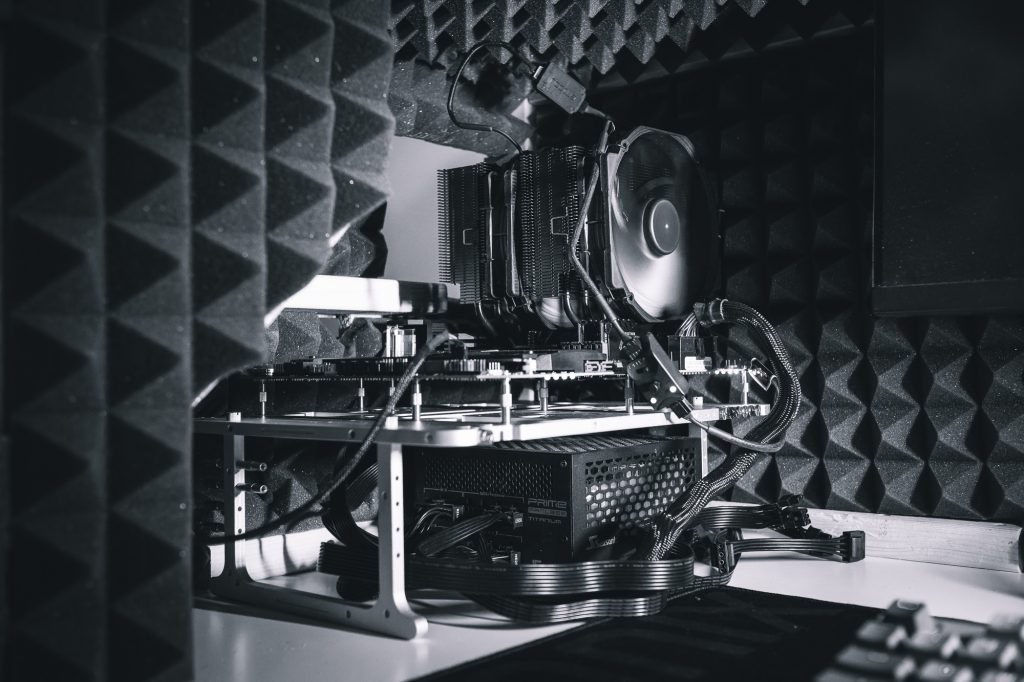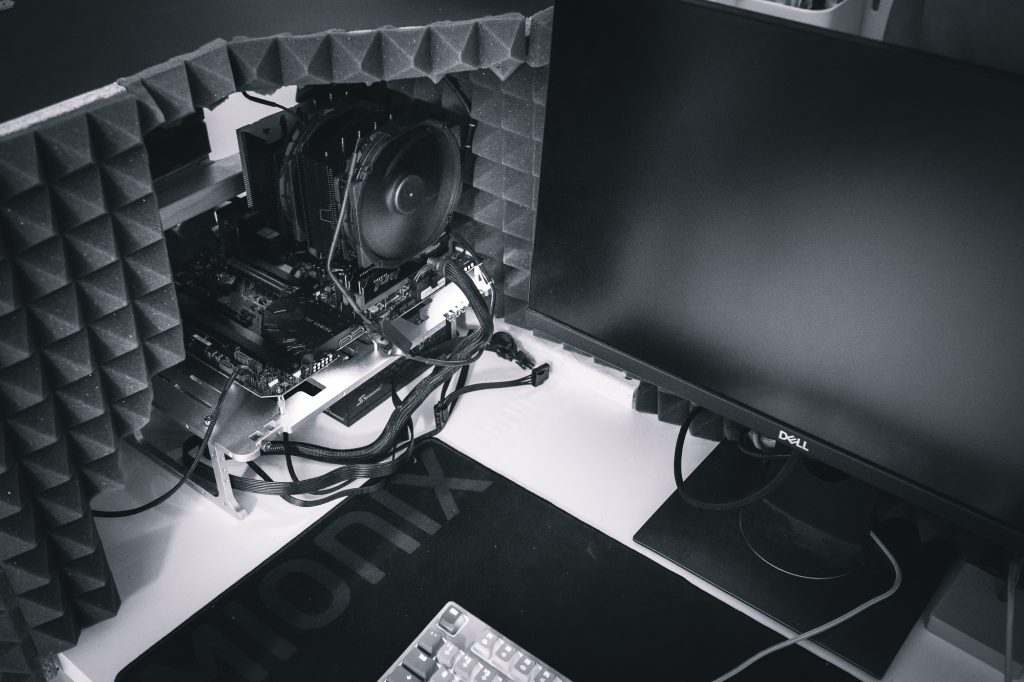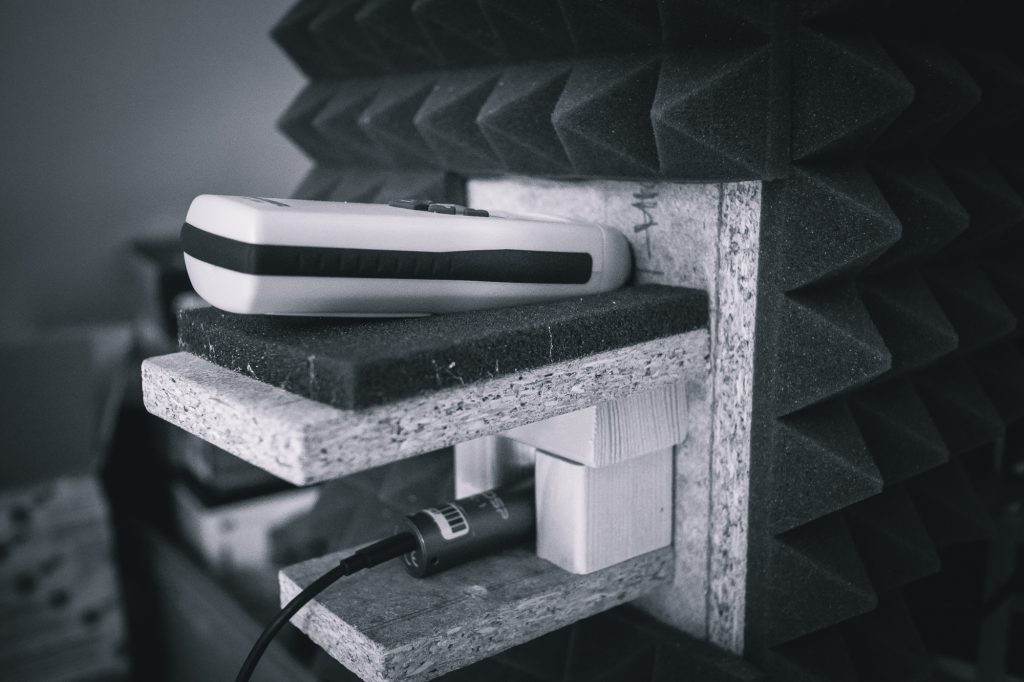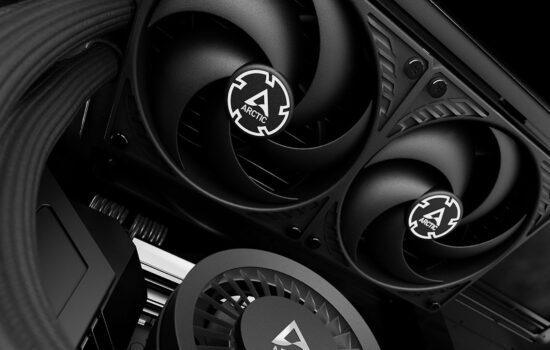Measurement methodology
Another cooler that we will have time to look at this year is the Scythe Fuma 3. This cooler uses several atypical design elements, which makes it different from the usual dual-tower coolers in its class. Moreover, with a price tag of just over 50 EUR, it could offer an interesting price/performance ratio. Additionally, this is my first experience with a Scythe cooler, so I’m also duly curious to see how the Fuma 3 performs in stress tests.
Testing methodology
As a test processor and heat generator I use the Intel Core i7-11700K on the Asus TUF Gaming Z590-Plus WIFI motherboard. The entire build is mounted on a Streacom BC1 frame with no fans to provide airflow. Acoustic shielding (acoustic foam on OSB boards) is installed around the test rig to eliminate ambient noise. The Voltcraft SL-100 calibrated noise meter is placed perpendicular to the cooler in a fixed position relative to the motherboard at a distance of approximately 35 cm from the processor socket.
Stress tests are performed using Prime95 with a duration of 30-35 minutes. Coolers are tested at three standardized noise levels (36, 39 and 42 dBA) and then at maximum speed. In addition, I am gradually adding tests at 45 and 48 dBA levels and you will also find this data in the results over time. The tests are run in two sets based on the thermal output of the processor.
The first set of tests is at 125 W, i.e. the forced PL1 limit of the processor. In the second set, the power draw is then about 210 W (4500 MHz at 1.285 V). However, this second level represents a very high concentration of heat per mm2 due to the small size of the chip itself. Thus, not all coolers can be expected to pass this set of tests at all noise levels. For example, no cooler has reached the 36 dBA level at this load, and I ended up eliminating it from the tests after some consideration.
The highest temperature reached after the test is always recorded. All data regarding temperatures and thermal output of the processor are obtained from HWiNFO64. The measured values are then adjusted against the temperature in the room as the resulting Delta T. The test success limit is set to 75 °C. Any higher value means a risk of processor temperature above 95-100 °C and a risk of thermal throttling. Therefore, if the cooler does not pass the load with a Delta T value below 75 °C, such a test is marked as a failure.
- Contents
- Key features
- Measurement methodology
- Results – 36 dBA
- Results – 39 dBA
- Results – 42 dBA
- Results – 45; 48 and 51 dBA
- Results – maximum speed
- Spectral analysis of noise
- Conclusion and evaluation
















About the ”weaker” results: A result of the averageness of the Kaze Flex II 120 (Slim) fans combined with poorer heat transfer within the second tower (due to the relatively large separation of the rear half of the fins from the heatpipe)?
Also Scythe claimed to have increased fin density on the Fuma 3 vs the Fuma 2, which uses the same fans (but initially capped at 1300RPM or so). We know the Kaze Flex fans don’t perform that well on high impedence scenarios and they are not optimized for higher RPMs either, yet the Fuma 3 seems to have been designed foe higher speed operations. From other tests I have seen, the 3 only barely outperform the 2 at higher fan speeds, which means it’s bound to perform worse at lower fan speeds.
You can see the heatpipe position at the rear fin stack being more favourable for the 2 as well.
Kaze Flex in general don’t perform well, they have pretty high noise floor making it impossible to set them to be quiet, completely defeating the purpose of Ninja 5 I had
I wonder how would that heatsink fare with dual A12x25 (seeing how tiny U12 can do so much!) and with dual T30, it’s not the most advanced one but the sheer size of that thing should give it some performance, additionally pretty big mass would smooth out short peaks
The heatsink by itself will probably be somewhat similar to the D12L. Based on official drawings, they in fact have pretty similar volume allocated for the fin stack (around 125x100x88 mm, WxHxD). Maybe slightly more height for the Fuma, but width and depth are identical. However, the heatpipes on the Fuma have much more bends which will reduce efficiency.
With a good fan like A12x25, the front fan probably isn’t needed, as we can see in U12A/D12L tests where an additional fan doesn’t help much. I’m thinking the design of the Fuma 2/3 is mainly the result of finding the best solution they have given the poor performance of their fans (so they need both for acceptable performance instead of only needing one). Once they have a much better fan (Grand Tornado for instance), we should see them forgoing the slim fan altogether.
I meant the gigantic heatsink of Ninja, not Fuma, probably didn’t put it clearly enough though
Fuma is… quite fine, just held back by the fans mostly
the tiny heatink of U12A may indeed not benefit much from the second fan but it may help achieve lower noise levels when the top performance isn’t needed
also U12A is guiding the air through thanks to the “sealed” sides while Ninja is open and very thick so it likely will lose a lot of performance with just a single fan
overall i believe we need a proper database of custom coolers, mixing and matching components to achieve results exceeding what’s possible out of the box
You’re in luck because this very site has tested Ninja 5 in different airflow conditions before.
https://www.hwcooling.net/en/how-sensitive-is-ninja-5-to-airflow-changes/
seems running F12 doesn’t help much but I’m almost certain using A12x25 at a low speed would make it both more quiet and more performant than stock (likely my target 650RPM would perform better than Kaze Flex while being actually inaudible from under the desk), same thing should happen with T30 (and 600RPM for that one) but adding another 10mm to the size of that thing may be more than unreasonable and there’s no way I’d fit it in my case anyway
“German quality” is slowly becoming the new “Chinese quality”
Scythe is a Japanese company though.
I’m hoping to get some input on Thermalright’s huge lineup of coolers. Specifically, which are the best. The commotion about the PA120 really this year was obviously an orchestrated marketing effort by TR, with many popular reviewers getting in on the action. However, it has become increasingly obvious to me that the PA120, as Steve@GN pointed out, can only handle so much heat before being overwhelmed. At first, some reviews suggested that the FC140 is the best, although it’s several dBA louder, and then the PS120 was mentioned, but it’s only marginally better than the PA120 until you get to the top end of RPM when the latter gets noisy. Now I’ve just seen
an HW Canucks video about the new DRPs, which shows that the PS120 and FS120 do the best on a hot 13th gen i9K Intel, with the FS ultimately winning out for both temps and noise. This does seem to contradict some other reviewers but I haven’t seen much about the FS yet.
Can you guys share any insights, since there’s very little on this site about their coolers?
I have not been in contact with Thermalright for a very long time, but that has changed and in 2024 the situation around testing their stuff will improve. We already have the HR-10 2280 SSD cooler in our testlab and I believe we will follow up with something else.
My experience with Thermalright goes back to when the Silver Arrow series of coolers was still relevant – the efficiency of the SB-E was great. Significantly lighter cooler than the Noctua NH-D15 and yet more efficient.
Your results for this cooler are much worse than in other reviews. Is your testing methodology substantially different to what other hardware sites do?
Can you please let us know which reviews you are comparing with? I don’t think our results would be in conflict with, for example, what sts-tutorial or Machines & More measured. I consider those to be respectable.
The Fuma 3 is a cooler with average fans and also an average heatsink design-wise. It is very unlikely that the results presented by Hardware Cannucks, for example, are achievable. Behind top-notch results there must also be top-notch technical implementation of partial things that include psychoacoustic optimizations between the fans and the heatsink. The Fuma 3 is a very decent cooler, but it doesn’t belong to the very top. When this cooler performs great for someone and is among the best, you have to ask what explains it.
Did you also come across our additional tests where we measured the Fuma 3 with two 25mm thick fans or with the addition of a third fan? After this modification (with three fans) the efficiency is already comparable to the Noctua NH-D15 or even a bit higher. Do you think that for some reason it makes sense for the Fuma 3 to achieve significantly better results?
Thanks for replying. For example, in the STS review the difference between the Fuma 3 and the NH-D15 at 250 W is less than 4 degrees, and in the review at Tom’s Hardware (https://www.tomshardware.com/reviews/scythe-fuma-3-review/2) there is only 1 degree difference between the Fuma 3 and the Assassin IV, but the Fuma 3 is well behind those coolers in your review: for example, 11 degrees compared to the Assassin IV at 210 W. But maybe the conditions are very different, hence my question.
I also saw a customer review in Amazon reporting to have an unit with a fan that was not working in PWM mode, that left me wondering if Scythe could have QC problems and some units were not working as intended.
According to what you write, our results and the results of STS scale quite well, don’t they? 🙂
Tom’s Hardware results are strange. It seems quite unlikely that the CM MA824 Stealth and DeepCool Assassin IV on the Intel platform would finish below the Noctua NH-D15S or comparable (I can’t find out from the article on THW in what exact conditions it was tested… under some circumstances it might be that the NH-D15S is not a weaker cooler than for example the MA824, maybe with a very high system cooling airflow…). Here I consider it important to note that the NH-D15S (i.e. cooler with one fan) has lower TDP than the NH-D15 (with two NF-A15 PWM fans) at comparable noise level. The lower the noise level is set, the bigger the difference is, because as the airflow decreases, the heat dissipation from the front tower gets significantly worse. It’s more pronounced here than on other two-fan designs that clamp the middle fan tighter. The gap between the NH-D15 towers is extra large, which causes the pressure between half of the fins of the cooler to drop faster. The comparison between the NH-D15 and the NH-D15S is well illustrated by this older, but for this purpose (better understanding) useful database.